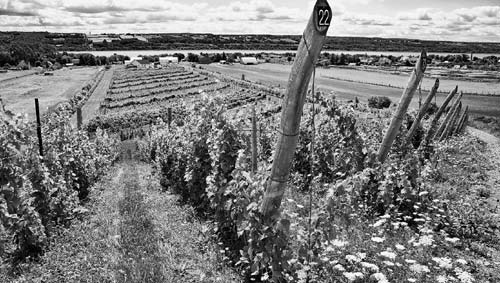
Côte-de-Beaupré and Île d’Orléans
Visiting Québec City might give you a clear picture of the province’s urban population, but if you really want to get to know the province and see the culture and nature that have shaped it, you have to go north.
Referred to as the régions (regions), the forests and the jagged cliffs of the St-Lawrence provide a real sense of the province and its rugged beauty. Barely a half-hour-drive from Québec you’ll find yourself in the picturesque Côte-de-Beaupré, lined with quaint ancestral homes—most continue to be residential homes. Not every historical event took place in and around the city; in fact, this area was where General Wolfe and his men camped before they laid siege to the city.
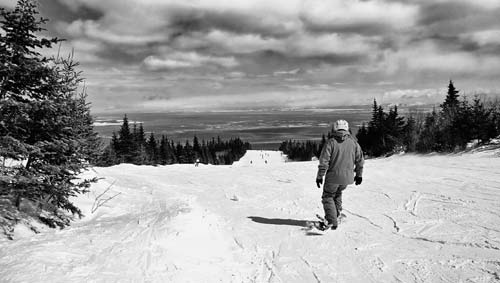
Once mostly farmland the area is now a large tourist destination thanks to the pilgrimages to the Basilique Sainte-Anne-de-Beaupré and Chute Montmorency. Across the water on the Île d’Orléans, however, things have stayed much the same as they have for hundreds of years. Île d’Orléans is full of vineyards and farms, and agri-tourism is a big part of the island; visitors should take full advantage by picking their own fruits and vegetables to take home.
Navigating the Côte-Nord (North Coast) couldn’t be easier; two highways take you to the same destination, and it all depends on whether you want the scenic route, Route 362, or the faster route, Route 138. Truth be told, even the faster route could be described as scenic; the high cliffs, rolling hills, and patches of tundra landscape as you head farther north are hard to ignore. Baie-Saint-Paul seems to emerge like a mirage, its church steeple sparkling on the shores of a low valley flanked by stone cliffs and the St-Lawrence. More picturesque than most of the other towns, it’s worth a wander.
North again, La Malbaie sneaks up on you from the corners of the twisting turning road, and though the sites aren’t much, the landscape is lovely. Once you’re this far north you might as well continue to the jewel of Charlevoix and cross the majestic Saguenay by ferry to Tadoussac. The massive cliffs that plunge into the river make for breathtaking scenery, and if you’re lucky enough to catch a view of the diverse whale life that thrives in these waters, you’ll understand the atypical beauty that defines the region and the province.
Some of these excursions can be done by day or even an afternoon by car. However, some places, including Tadoussac and the Saguenay Fjord are three hours (or sometimes more) away, so plan to spend at least a night in these locations. Of course, no matter how far afield you’re willing to travel, if you have the time, it’s always fun to stay a bit longer in order to really get to know a place. Though Québec is a big province and you could drive for hours without hitting on any sights, all the excursions in this section are easily reached, the longest taking at most three hours from the city.
Most of the sights are accessible by national highways, though in some places these highways slim down to two lanes. If you’re driving in winter, the journey could take longer, especially if there are bad driving conditions. Snow tires are required by law December-March; if you don’t have them on your car, avoid trips into the rocky and hilly Charlevoix, or rent a car with the right tires.
High season is May-October; those traveling north to Charlevoix later in the year should make sure to plan well ahead, or opt for a package deal at places like La Massif. Getting a hotel, dinner, and recreation in one deal will allow you to see the beauty of the area without worrying about whether there’ll be restaurants open or not.
| Côte-de-Beaupré and Île d’Orléans |
Minutes outside of Québec on Route 138, you’ll reach the Côte-de-Beaupré. Located on the banks of the St-Lawrence River, this historical area boasts ancient ancestral homes and open farmland running along the Route de la Nouvelle France, one of the oldest roads in North America. As you pass along the 50 kilometers of roadways, you’ll pass through a number of small towns, all of which are between the high cliffs of the Laurentians and the shores of the river.
From the Côte-de-Beaupré you can see the Île d’Orléans, an island in the stream of the St-Lawrence. Linking the two historical areas is the Île d’Orléans Bridge, which can be used by car, bike, or foot. The island itself has one main road, Chemin Royal, which circles the entire island. It’s dotted with towns, but much of the island is devoted to local agriculture and can be visited year-round.
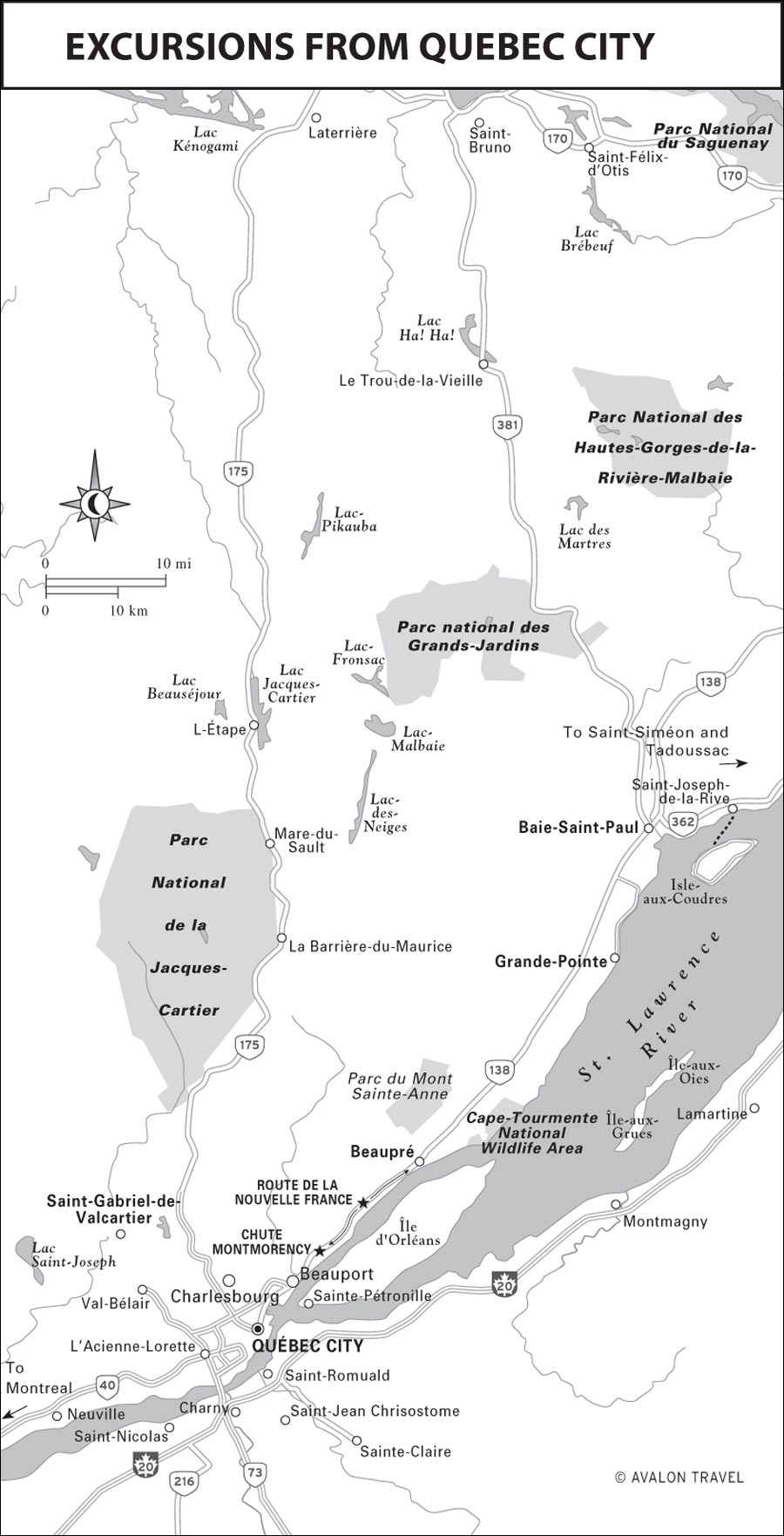
Leave Québec City heading northeast and you’ll soon be on the Route de la Nouvelle France (www.routenouvelle-france.com), one of the oldest roads in North America. In 1626 Samuel de Champlain established a livestock farm on Cap Tourmente farther along the river, but it was Bishop Monsignor de Laval who originally traced the road, which brought provisions from the Côte-de-Beaupré to the city.
All along the 50-kilometer road are heritage homes, some dating as far back as the 1600s. Each is designed in its own particular style, indicative of early New France architecture. Though many of the homes are private residences, the public can visit Maison Vézina (171 rue des Grenadiers, 418/822-3183, www.maisonvezina.ca, May-late-Aug. Tues.-Sat. 10am-4pm, Sept.-Apr. Tues.-Sat. noon-4pm, free). Built in 1720, it’s now an interpretation center and exhibition space. If you’re looking to get in touch with your roots, Centre de Généalogie (277 rue du Couvent, 418/824-3079, www3.telebecinternet.com/archives.chateau-richer, summer daily 9am-4pm, free) can help you with genealogical research, a popular Québécois pastime.
If you want a little history of the area, the Centre d’Interprétation de la Côte-de-Beaupré (7976 ave. Royale, 418/824-3677, www.histoire-cotedebeaupre.org, May-Oct. daily 9:30am-4pm, Oct.-May Mon.-Fri. 9:30am-4:30pm, $6) has lots of documentation and exhibits and is housed in an old seminary.
As you travel along the road, you’ll notice cavern-like structures built directly into the hillsides; these are root cellars, some of which date back more than 300 years. Also along the route is the Moulin du Petit Pré (7007 ave. Royale, 418/824-7007, www.moulin-petitpre.com, mid-Apr.-mid-Oct. daily 9am-5pm, $5 adult, $3 child). Founded in 1695, it’s the oldest operating flour mill in North America. Take a guided tour, then have lunch at the on-site café or get some bread for the road.
Carry on along the Route de la Nouvelle France and you’ll soon reach Chute Montmorency (4300 blvd. Ste-Anne, 800/665-6527, www.sepaq.com/ct/pcm) an 83-meter-high waterfall (even taller than Niagara Falls, as everyone will point out) that dominates the landscape between the cliffs of the Laurentians and the St-Lawrence. It’s a stunning natural wonder in the middle of lush greenery, and visitors can discover the falls by foot or take a cable car ($12 adult, $6 child round-trip). There’s access at either side of the falls year-round and a suspension bridge that allows you to cross along the top; it offers great views of Île d’Orleans and even looks onto Québec City.
This is the oldest pilgrimage site in North America, and people have been coming to Basilique Sainte-Anne-de-Beaupré (10018 ave. Royale, 418/827-3781, www.shrinesaintanne.org, May daily 6am-7pm, June-late-Sept. daily 6am-9pm, Oct.-Apr. Mon.-Sat. 6am-6pm, Sun. 6am-5pm) since the 1660s. The first chapel was constructed on the site in 1658 as a place of worship for the area’s new settlers and to house a statue of Sainte-Anne, Québec’s patron saint. She’s also the patron saint of shipwrecked sailors, and it was a group of Breton sailors caught in a storm that vowed to erect a chapel in Sainte-Anne’s honor if they got safely back to land. While the chapel was being constructed, a man with rheumatism was said to have been cured after laying just three bricks, and a pilgrimage was born.
The first basilica was built in 1876 to accommodate the legions of pilgrims who visited the shrine. The structure that exists today, built in the shape of a Latin cross and featuring 214 stained-glass windows, was constructed in 1926 after the first church was destroyed by fire in 1922. One image that strikes you as you enter the church is the multitude of crutches, club shoes, and other pieces of ephemera that hang on the pillars from those who have been cured. A small museum in the church’s parking lot exhibits some of the church’s treasures as well as donations made by pilgrims.
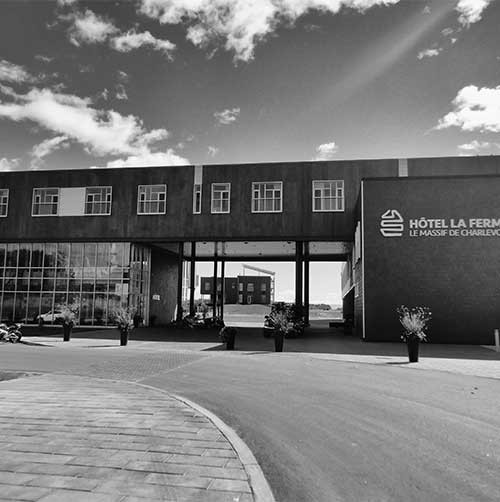

Clockwise from top left: Hôtel Le Ferme, Baie-Saint-Paul; Chute Montmorency, Cote-de-Beaupré and Île d’Orleans; the sand dunes in Tadoussac, Charlevoix.
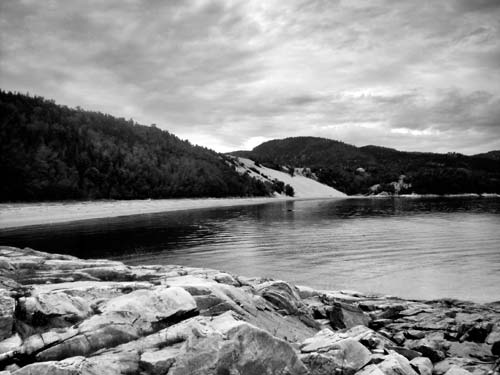
Located five kilometers from downtown Québec City, Île d’Orléans is an island in the middle of the St-Lawrence and one of the oldest parts of New France to be colonized. It measures 34 kilometers long and 8 kilometers wide. Explorer Jacques Cartier first called it Île de Bacchus, because of the amount of wild grapes found growing on the island. Today, it’s home to a number of small villages, but agriculture is still a large part of life on the island.
The first parish was founded here in 1661, and a visit to Maison Drouin (4700 chemin Royal, 418/829-0330, www.fondationfrancoislamy.org, mid-June-Aug. daily 10am-6pm, Sept. Sat.-Sun. 1pm-5pm, Oct.-May dates vary, $4) will give you an idea of what the early houses looked like. Built in 1730, it has been preserved in its original state.
Manoir Mauvide-Genest (1451 chemin Royal, 418/829-2630, www.manoirmauvidegenest.com, June-Aug. daily 10am-5pm, Sept.-Oct. Tues.-Sun. 10am-5pm, $6 adult, $5 senior and student, $4 child, children 5 and under free) offers a view of the seignorial home of the 18th century, with furniture, objects, and reenactments of daily life on view.
Agri-tourism is a big draw to the island; you can visit Cassis Monna & Filles (721 chemin Royal, 418/828-2525, www.cassismonna.com, May-Nov. daily 10am-6pm, free) and learn about how they make their black currant liqueur, or go for a tasting at Vignoble de Sainte-Pétronille (1A chemin du Bout-de-l’Île, 418/828-4554, www.vignobleorleans.com, May-Dec. daily 10am-5pm, free) and try their reds and whites as you look at the Chute Montmorency. Visitors are also welcome to pick their own fruits and vegetables at local farms, including Ferme la Rosacée (165 chemin Royal, 418/828-9662, June-mid-Oct. daily 8:30am-6:30pm, free), where you can pick everything from raspberries to seasonal vegetables and buy homemade products like jam, pickles, and ketchup.
If you left Québec City early in the morning, stop in at Patisserie Praline et Chocolat (7874 ave. Royale, 418/978-0528, www.pralinechocolat.ca, mid-June-early Sept. daily 8am-6pm, early Sept-mid-June Thurs.-Sun. 8am-6pm, $10) for some mouthwatering pastries. They offer 10 different kinds of viennoiseries (baked goods) made fresh daily, as well as artisanal bread, jams, and other treats.
Whether you’re looking for breakfast or dinner, L’Aventure (355 rue Dupont, 418/827-5748, www.laventure.ca, daily 11am-11pm, $30) in Beaupré has you covered with everything from grilled trout and filet mignon to eggs Benedict, all in a relaxed atmosphere. If you’re in the mood for something less refined, Casse Croute Chez Chantale (17 rue de l’Église, 418/827-7005, daily 8:30am-7:30pm, $10) has over 100 different kinds of poutine on the menu, including the house specialty, poutine with goose.
On Île d’Orléans, tuck into some traditional cuisine or take part in the cabane à sucre experience at Le Relais des Pins (3029 chemin Royal, 418/829-3455, www.lerelaisdespins.com, June-Sept. daily 11am-9pm, winter by reservation only, $15). Open year-round, this delightful log cabin has lots of natural light and a modern take on decor.
If you’ve got a sweet tooth, Chocolaterie de Île d’Orléans (150 chemin du Bout de Île, 418/828-2250, www.chocolaterieorleans.com, $10) will satisfy with rich chocolate desserts, homemade ice cream, and delicious coffees.
Treat yourself to fine dining overlooking the St-Lawrence at La Goéliche (22 chemin de Quai, 418/828-2248, www.goeliche.ca, daily 8am-8:30pm, $40), where breakfast includes dishes like French toast with custard, and dinner has choices like rack of lamb and boneless rib eye with shallots.
The site of a livestock farm established by Samuel de Champlain in the early 1600s, Cap-Tourmente (570 chemin du Cap-Tourmente, 418/827-4591, www.captourmente.com, mid-Apr.-Nov. daily 8:30am-5pm, Jan.-Mar. daily 9am-5pm, $6) became a farm headed by Monsignor de Laval in 1664. It was an active farm well into the 20th century, and some of the early buildings still remain. Today the area is mostly a nature reserve; it’s a great place to bird-watch and learn about the greater snow goose and American bulrush marshes. Interpretive guides and 20 kilometers of hiking trails are available.
One of the best courses in eastern Canada, Le Grand Vallon (100 rue Beau-Mont, Beaupré, 418/827-4561, www.legrandvallon.com, May-Nov. daily dawn-10pm, $45-95 for 18 holes), designed by Howard Watson, was once nicknamed the “minister’s club” because of the number of high-level politicians that frequented the links. Along the 6,583-yard course there are four lakes and 42 white-sand bunkers, and the changing scenery moves from rolling tree-lined fairways to a large open plan at mid-course. Equipment rentals, driving range, and lessons are also available here and an electric cart and use of the practice range are included in the green fee.
The most popular ski station in the Québec City region, Mont-Saint-Anne (2000 blvd. Beau Pré, Beaupré, 888/827-4579 www.mont-sainte-anne.com, mid-Nov.-mid-Apr. Mon.-Fri. 9am-9pm, Sat.-Sun. 8:30am-9pm, $64 adult, $68 senior, $53 youth, $36 child 7-12) offers both day and night skiing, with the highest elevation of night skiing in the country. Officially opened in 1966, the history here goes back to 1947, when the Canadian Championships where held on these slopes. About an hour’s drive north of the city, 66 trails cover both the north and south face of the mountain. It also has popular cross-country and snowshoeing trails.
Cozy but modern, the 31 rooms at Auberge la Camarine (10947 blvd. Ste-Anne, 800/567-3939, www.camarine.com, $100-250) in the Côte-de-Beaupré are often fitted with a warming gas fire, perfect after a long day outdoors.
On Île d’Orléans, grab a room with a view at Auberge La Goéliche (22 chemin de Quai, 418/828-2248, www.goeliche.ca, $104-144). Named after a small schooner, the white clapboard house has charm in spades; the views of the river and well-appointed rooms with country touches like handmade quilts make it an ideal choice.
Total country charm is the best way to describe Auberge Le Canard Huppé (2198 chemin Royal, 800/838-2292, www.canard-huppe.com, $150-250). The oversized wood furniture, pine paneling, and wood floors are welcoming, and the beautiful garden and seasonal regional cuisine on offer in the restaurant are the icing on the cake.
Before you go to the area, read up on the Côte-de-Beaupré area at www.cotedebeaupre.com, which offers the useful information on restaurants, hotels, grocery stores, and events. Once you’re on the ground, the Côte-de-Beaupré Tourist Office (3 rue de la Seigneurie, Château-Richer, 866/932-9082, Mon.-Sat. 9am-5pm, Sun. 10am-4pm) can provide you with hands-on information.
The year-round Île d’Orléans Tourist Office (490 Côte du Pont, St-Pierre, 418/828-9411 or 866/941-9411, www.iledorleans.com, July-Aug. daily 8:30am-7:30pm, Sept.-June. daily 10am-5pm) has a wealth of information and tips on hand.
Old Québec Tours, also known as Tours Dupont (800/267-8687, www.tourdupont.com, June-Oct. daily 9am and 1pm, Nov.-May daily 1pm, $50), offers different tours that essentially drop you off at the highlights along the Côte-de-Beaupré and pick you up later. They leave from three points throughout Québec City for your convenience, so check before you book.
Sainte-Anne-de-Beaupré can be reached by Intercar (320 Abraham Martin, 888/861-4592, www.intercar.qc.ca) coach, which leaves from Québec City’s Gare du Palais bus terminal heading toward Baie Comeau three times a day Monday-Saturday and once on Sunday. A return ticket costs $16 and the journey takes 25 minutes.
Bike path Corridor du Littoral will take you right from Québec’s Vieux-Port all the way to Chute Montmorency and even along the Route de la Nouvelle France. Once you’ve made it onto the Île d’Orléans, bikes are available to rent from Écolocyclo (517 Chemin Royal, 418/828-0370, www.ecolocyclo.net, May-mid-June Sat.-Sun. 9am-6pm, mid-June-Sept. daily 9am-6pm). The Chemin Royal encircles the island and is a great way to sightsee by bike.
The simplest and quickest way to get around is to take Autoroute 440 east out of Québec City and watch for the signs; all of the sights are well marked out with the exits that accompany them. To get to Île d’Orléans, take the Pont Île d’Orléans to the island.
| Charlevoix |
Some of the most stunning views of the province can be found here. People come here to camp, hike, and to catch a glimpse of the whales.
Follow Route 138 north out of Québec City and you’ll come across some of the most spectacular scenery you’ve ever seen. The impact of a meteorite 350 million years ago has shaped the face of the Charlevoix region and could be the cause of its mysterious seismic activity (rest assured—most temblors hit little more than 2.0 on the Richter scale).
One of the first vacation destinations in Canada thanks to a couple of enterprising Scottish soldiers, Charlevoix’s landscape is distinct in its variety. At times pastoral and hilly, the region’s high cliffs and breathtaking fjords are adorned with tundra, while nearby, steep sand dunes rise unexpectedly along the coastline. These manifold landscapes translate into an area rich in biodiversity, where moose and caribou thrive alongside an astounding range of sea life. Where else can you sit on a sandy beach waiting to catch a glimpse of a pod of white beluga whales?
One of the biggest towns in Charlevoix, Baie-Saint-Paul is known for its unique artist community, galleries, off-beat boutiques, and as the birth place of Cirque du Soleil. The home of roughly 7,000 full-time inhabitants, the downtown core is quaint, full of shops and cafés, and is a lovely place to spend the afternoon strolling the streets no matter the season.
Musée d’Art Contemporain Baie-Saint-Paul (23 rue Ambroise-Fafard, 418/435-3681, www.macbsp.com, summer Tues.-Sun. 11am-5pm, winter Tues.-Sun. noon-5pm, $6 adult) honors the area’s artistic heritage with a collection and temporary exhibits dedicated to contemporary works. Founded in 1992, the museum is located in what was once an old cinema and is a definite must on any itinerary.
Born in Switzerland in 1895, artist René Richard moved to Canada with his family as a child and was working as a fur trapper in northern Alberta by the time he was 18. By the 1940s he’d settled in Baie-Saint-Paul, where he painted some of his best-known landscapes and hosted a number of revered Canadian artists, including members of the Group of Seven. His century-old house, Maison René-Richard (104 rue St-Jean-Baptiste, 418/435-5571, daily 10am-6pm, free), has remained unchanged and is located on the main street. Visitors get the chance to see both his home and his work in the adjoining gallery.
On the outskirts of town you’ll find Le Moulin de la Rémy (235 Terrasse de la Rémy, 418/435-6579, www.moulindelaremy.com, summer Tues.-Sun. 10am-4pm, $5). Built in 1827, this is one of the few flour mills still active in Québec; tours and tastings are available throughout the summer and visitors are invited to explore the surrounding paths and countryside. Pick up a fresh loaf at the bakery, traditionally made with wheat grown in Charlevoix and ground on-site.
Sustainability is the focus of Habitat 07 (212 rue Ste-Anne, 418/435-5514, www.habitat07.org, May-Aug. daily 10am-6pm, Sept.-mid-Oct. Sat.-Sun. 10am-6pm, $5 adult, $2 student), an ecofriendly house built to showcase the latest developments in new energy and recycling. Opened in 2007, the construction methods used were inspired by ancient practices and used local, sustainable materials. The best part of the house, though, is the amazing view of the St-Lawrence River.
Baie-Saint-Paul has the best range of restaurants in the region. Fans of a good microbrew shouldn’t miss Le Saint-Pub (2 rue Racine, 418/240-2332, www.saint-pub.com, late May-Oct. daily 11:30am-10pm, Nov.-late May daily 11:30am-8pm, $25). This pub and bistro keeps things local and serves seasonal mussels, fresh fish, Charlevoix sausage, and deer steaks. They also offer more regular pub-style dishes like nachos and fries.
Relaxed dining can be found at Vice-Café (1 rue Ste-Anne, 418/435-0006, daily 11:30am-onward, $20), situated directly in front of the church. Their specialties include grilled salmon and crêpes. Head there for dinner on Friday night and stay for the local musical entertainment.
A French-born and trained chef puts his skills to work on local ingredients at the Mouton Noir (43 rue Ste-Anne, 418/240-3030, www.moutonnoirresto.com, daily 11:30am-3pm and 5pm-10pm, $35). The emphasis here is on modern French cuisine and the menu includes everything from organic pork tongue to quail and beet ravioli. Book ahead, and expect a crowd and lively atmosphere.
When Hotel La Ferme opened its doors in 2012, it brought a new level of culinary excellence to its surroundings. Their in-house restaurant, Les Labours (50 rue de la Ferme, 418/240-4123, www.lemassif.com, Sun.-Wed. 11:30am-2pm and 6pm-9pm, Thurs.-Sat. 11:30am-2pm and 5pm-10pm, $25), serves up tasty, modern cuisine—wild mushroom salad, roasted arctic char, pan-seared veal liver—in a chic yet cozy atmosphere. Get a seat at the bar and watch as the chefs do their magic. This is a great way to experience the hotel, even if you’re not staying here.
Once you’re in the area you might as well take advantage of the nature that’s available to you. West of Baie-Saint-Paul is the Parc National des Grands-Jardins (800/665-6527, www.sepaq.com/pq/grj), open year-round. This gorgeous national park has some of the most interesting vegetation, with a mix of both taiga and tundra. The landscape is vaguely arctic, with thick layers of lichen and black spruce forest. Home to a large caribou population, it has many activities available, including 34 kilometers of hiking trails in the summer, as well as kayaking and canoeing. In winter, visitors can use the 55 kilometers of cross-country ski trails and try their hand at ice fishing.
One of the best hills in the province, Le Massif (877/536-2774, www.lemassif.com, mid-Dec.-mid-Apr. daily 8:30am-4pm, $64 adult day pass) is the area’s largest ski mountain. Many high-ranking skiers come to train here, but even if you’re more comfortable on the bunny runs, the views alone are worth the fees. It’s on a cliff that looks out over the St-Lawrence, and there are times on these runs when you’re sure the bottom is going to be on the shores. With 49 different trails of varying levels, it has something for everyone.

skiing at Le Massif, Charlevoix.
Daniel Gauthier, one of the founding members of Cirque de Soleil, opened Hôtel La Ferme (50 rue de la Ferme, 418/240-4100, www.lemassif.com, $150-400) as a way of giving back to the community, and as such, the hotel is more than just a place to rest your head. Located on a tract of landed facing the St-Lawrence and between two rolling hills, it has a concert hall, two restaurants, a café, a spa, a gym, and a mini-farm, as the name suggests. It also happens to be the final destination on the whistle-stop train, La Massif, which brings visitors to the region by way of a riverside journey. The hotel itself is well-appointed, with a modern rustic design—exposed ceiling beams, heavy gray felt blankets, all-white decor—and is made up of a cluster of four buildings. With 145 rooms on offer (including a few dorm options), they can accommodate just about any budget.
The stone-clad, 30-room inn Maison Otis (23 rue St-Jean-Baptiste, 418/435-2255, www.maisonotis.com, $120-260) in Baie-Saint-Paul has its own sort of cozy charm with wood furniture, floral bedding, and stone walls. Slightly more modern but still with that floral country vibe, Auberge La Muse (39 rue St-Jean-Baptiste, 800/841-6839, www.lamuse.com, $120-400) is ideally located on a tree-lined street in the center of town, and the rooms are tastefully decorated.
Baie-Saint-Paul Tourist Office (6 rue St-Jean-Baptiste, 800/677-2276, winter daily 9am-4pm, summer daily 9am-7pm) is just off the highway on a hill overlooking the city below; it’s a great view, but the turnoff is sharp. The website www.tourisme-charlevoix.com is also a great online resource.
Intercar (320 Abraham Martin, 888/861-4592, www.intercar.qc.ca) coaches leave from Québec City’s Gare du Palais bus terminal heading toward Baie Comeau three times a day Monday-Saturday and once on Sunday. The same bus runs all along the Charlevoix coast. A round-trip ticket to Baie-Saint-Paul costs $39 and the ride takes one hour and 15 minutes and drop off is at the Baie-Saint-Paul Library (9 rue Forget) in the middle of the town. When heading out of town, the bus departs from a gas station at 909 boulevard Monseigneur-de-Laval, which can be reached by either a local bus system or a taxi (418/435-5000). Check with the bus company at the time of departure to be sure.
Take Autoroute 440 out of Québec City and continue past Côte-de-Beaupré on Route 138 all the way to Baie-Saint-Paul. Depending on traffic and weather conditions, the drive should take approximately an hour and 20 minutes.
The exclusive Train Le Massif de Charlevoix (877/536-2774, www.lemassif.com, Mar.-mid-Oct., $110-275) offers stunning views, great food, and a totally unique way to get from Québec City to Baie-Saint-Paul. The train departs Québec City twice daily from the base of the Chute Montmorency, once early in the morning and once at noon. The train pulls into the station at La Ferme, about a five-minute walk from Baie-Saint-Paul’s downtown core.
Off the shores of Baie-Saint-Paul is Isle-aux-Coudres, one of the most picturesque islands in the St-Lawrence. Hop on the free ferry from St-Joseph-de-la-Rive just south of Baie-Saint-Paul and take the 15-minute ride out to the island.
Once on the island, it’s easy to be transported to an earlier time. Les Moulins de Ilse aux Coudres (36 chemin du Moulin, 418/760-1065, www.lesmoulinsdelisleauxcoudres.com, mid-May-mid-Oct. daily 10am-5:30pm, $9 adult, $5 child), a watermill and windmill that were built in 1825 and 1838, respectively, are a visceral link to the past. Still in operation today, you can tour these working mills and learn how the buckwheat and wheat were once ground all over the region. Guided tours are available, but you’re also welcome to explore all buildings and surroundings on your own.
With a parish that dates back to 1741, Église Saint-Louis de Isle-aux-Coudres is one of the oldest religious sites on the island, built in 1885. It boasts hand-painted frescoes and impressive stone work.
No matter the season, stop in at Cidrerie et Verger Pedneault (3384 chemin des Coudriers, 418/438-2365, www.vergerspedneault.com). Opened in 1918, this family-run apple orchard also creates their own apple cider (alcoholic and non), jams, syrups, and honey. They offer tours of their premises year-round and apple-picking come the fall.
On Isle-aux-Coudres, many restaurants are located in hotels. La Marinière (1933 chemin des Coudriers, 418/438-2208, daily 5pm-10pm, $25) is located in the interestingly named Hôtel Motel Les Voitures d’Eau (Hotel Motel for Water Vehicles) but offers a menu pre pared exclusively with local products, including Charlevoix meats and seafood. The food is so fresh here that the menu changes daily.
If you like a little entertainment with your meal, Le Cabaretier (1064 chemin des Coudriers, 418/438-1070, daily 10am-5pm, $25) does double duty as both a bistro and wine bar as well as a typical boîte à chansons, the perfect end to a day cycling around the island. Another great option for the hungry traveler is a stop at Casse-Croûte Le Mouillage (922 chemin des Coudriers, 418/438-2208), where specialties include hot dogs, poutine, club sandwiches, BLTs, and anything else that’s greasy yet delicious.
The menu at Hôtel du Captitane (3031 chemin des Coudriers, 418/438-2242, daily 5pm-9pm, $25) meanwhile focuses on healthier local recipes and also has an extensive menu of crepes.
Named Isle-aux-Coudres after the hazelnuts that Jacques Cartier found here, the 11-kilometer-long and 3-kilometer-wide island is easily explored by bike. Vélo-Coudres (2926 chemin des Coudriers, 418/432-2118, www.charlevoix.qc.ca/velocoudres, May-June and Sept. daily 9am-5pm, July-Aug. daily 8am-sunset, $7/hour) has different models available, including tandem, kids’ bikes, and even quadricycles with room for a family of four.
Located on the northern tip of the island, L’Hôtel Cap-aux-Pierres (444 chemin la Baleine, 888/222-3308, www.dufour.ca, $84-250) has 46 rooms, tastefully decorated with wood floors, antique-style furniture, and a country feel. Each room has classic views of both the river and the garden. The hotel also has an outdoor pool.
Hôtel du Capitaine (3031 chemin des Coudriers, 418/438-2242, www.hotelducapitaine.com, $90-150) is also located on the northern tip, but closer to where the mainland ferry docks. The rooms have a country feel with their floral bedspreads and wooden furniture; the views of the river, however, are stunning and you can opt to have a gourmet dinner included in the price. The breakfasts are complimentary.
Boating fans might want to opt for the Hôtel Motel Les Voitures d’Eau (1933 chemin des Coudriers, 418/438-2208, $90-200), since a stay here means you can check out their boating museum. The accommodations have a rustic feel reminiscent of a cottage getaway, though the exterior looks like just about any highway-side motel. In addition to the mini museum, they also offer bike rentals and have a saltwater pool.
Isle Aux Coudres Tourist Office (1024 chemin des Coudriers, 800/667-2276, mid-May-mid-Oct. daily 8am-noon and 1pm-4pm) can be found on the main road, just a short walk from the quay. Though it’s open daily during the peak-months, it closes during the off-season (typically after Canadian Thanksgiving). Read up on the island at www.tourismeisleauxcoudres.com before packing your bags.
The only way to get to the island is by ferry. The ferry departs from Saint-Joseph-de-la-Rive and arrives at Saint-Bernard-sur-Mer on the west coast of the island. The trip takes about 15 minutes. It can take approximately 367 passengers and 55 vehicles. The boats are run by a government agency Traversiers (877/787-7483, www.traversiers.com) and as such the service is free. Boats leave the mainland and the island about once an hour during peak-season, but travelers should contact the company directly before making concrete plans. Once on the island, visitors are welcome to drive or ride a bike.
If you want to continue exploring the region of Charlevoix, stay on the mainland and continue north from Baie-Saint-Paul on Route 362 until you arrive at La Malbaie, one of the oldest tourist spots in the region. Originally called Murray Bay, the area was first made popular by two Scottish officers who saw the potential in the area’s beauty and made it the top resort choice from the 19th century right up until the 1950s.
Learn all you need to know about the region at Musée de Charlevoix (10 chemin du Havre, 418/665-4411, www.museedecharlevoix.qc.ca, June-mid-Oct. daily 9am-5pm, mid-Oct.-May Mon.-Fri. 10am-5pm, Sat.-Sun. 1pm-5pm, $7 adult, $5 senior). This charming museum offers exhibitions about the region’s culture and history, including photographs of beluga whale-hunting, artifacts from Manoir Richelieu, and folk art from the 1930s and ’40s.
In more recent times, one of the biggest draws to the region has been the Casino de Charlevoix (183 ave. Richelieu, 800/665-2274, www.casino-de-charlevoix.com, Mon.-Thurs. and Sun. 11am-midnight, Fri.-Sat. 11am-3am, free). Opened in 1994, it has cherrywood paneling, granite floors, and is a step up from most casinos. Visitors must be 18 years old or over to enter.
Run by two head chefs, Vices Versa (216 St-Etienne, 418/665-6869, www.vicesversa.com, Tues.-Sat. 6pm-10pm, $65 for a table d’h ôte) is a unique take on fine dining. Customers are presented with two menus (one created by each chef) and must decide between the two. Choices include sautéed scallops vs. scallop cerviche, or duck breast with potatoes and fennel or duck confit with quinoa cake and goat cheese cream. At the restaurant, it’s all about pleasing the diner and the chefs’ friendly rivalry. Situated on a busier street, it has a relaxed elegance that perfectly suits the flavors flowing from the kitchen.
Sometimes a little comfort food is the only way to go. Pizzaria Du Poste (448 rue St-Étiennem, 418/665-4884, www.pizzariaduposte.ca, June-Aug. daily 11am-midnight, Sept.-May Sun.-Tues. 11am-10pm, Wed.-Sat. 11am-midnight, $20) serves up Italian favorites like spaghetti, lasagna, and pizza in a convivial and sometimes raucous atmosphere. The pizza is thin-crusted and topped with the usual suspects and some that are more unexpected (shrimp and crab, anyone?). What’s best about this place is the low-key atmosphere and the outdoor patio in the summer.
Named after a series of valleys, Parc National des Hautes-Gorges-de-la-Rivière-Malbaie (800/665-6527, www.sepaq.com/pq/hgo, late May-Oct. daily 24 hours) has steep sloping mountains that fall to meet Rivière Malbaie. With its unique mix of fauna, Hautes-Gorges is one of the most beautiful spots in eastern Canada. Not far west from La Malbaie, it offers a huge amount of outdoor activities, like boat cruises, rock climbing, cycling, and 33 kilometers of hiking. Swimming, canoeing, and kayaking can also be done here.
Murray Bay Golf Club (1013 chemin du Golf, 877/665-2494, www.golfmurraybay.com, $44) is one of the oldest courses in the country and the third oldest in North America. It first opened its links in 1876. Built high above the cliffs that look out over the St-Lawrence, it’s a spectacular place to tee-up and a must for any golfer visiting the area.
In La Malbaie, one of the area’s biggest draws is the romantic Fairmont Le Manoir Richelieu (181 rue Richelieu, 866/540-4464, www.fairmont.com, $140-350). Built in 1899, in a similar style as the Château Frontenac, it sits atop the Pointe-au-Pic overlooking the St-Lawrence River. Destroyed by fire and rebuilt in 1929, the hotel today is a luxury resort with an adjoining 18-hole golf course and an on-site spa, as well as five different restaurants. The rooms are elegant and tastefully decorated and aim for a comfortable instead of sleek luxury.
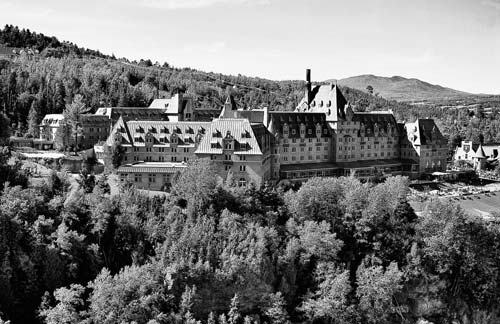
the majestic Fairmont Le Manoir Richelieu in La Malbaie, Charlevoix.
If you’re looking for a more intimate luxury, head to La Pisonniere (124 rue St-Raphaël, 800/387-4431, www.lapinsonniere.com, $240-450), a family-run inn with incredible views and the stamp of approval from the Relais Château. Modern yet cozy, the rooms feature fireplaces, sumptuous linens, classic wingback chairs for reading, and private balconies. If you want to leave your abode, you have the option of heading to the indoor pool, their private beach, the in-house spa, or the wine cellar for a tasting.
Auberge des Peupliers (381 rue St-Raphael, 418/665-4423, www.aubergedespeupliers.com, $140-250) keeps things luxurious but at a more affordable price point. There’s a contemporary edge to this hotel that others in the region lack, making it ideal for urbanites or those looking for a modern hotel in rustic settings.
La Malbaie Tourist Office (495 blvd. de Comporté, Route 362, 800/667-2276, daily 8:30am-4:30pm) is right on the water looking out over the river and has a nice park in front in which to take a break.
If traveling by public transport, hop on the Intercar (320 Abraham Martin, 888/861-4592, www.intercar.qc.ca) coach which leaves from Québec City’s Gare du Palais bus terminal heading toward Baie Comeau three times a day Monday-Saturday and once on Sunday. The trip will take about two hours from Québec City and you’ll be dropped off and picked up at Dépanneur J. E. Otis (46 rue Ste-Catherine) in the middle of the town. A round-trip ticket costs $60.
Follow Autoroute 440 out of Québec City and continue north on Route 138 all the way to La Malbaie. Depending on traffic and weather conditions, the drive should take approximately two hours.
Tadoussac is the meeting point of the Saguenay and St-Lawrence Rivers. Before you can get to Tadoussac, however, you have to take a ferry across the convergence of these two mighty waterways. A free ferry will take you the short trip across the water to the historic town, one of the oldest places in Québec. It was France’s first trading post and was established in 1600. Today the area’s main draw is the rich marine life that thrives here, thanks to the warm St-Lawrence saltwater and the freshwater of the Saguenay.
Though the town itself is quite small, it’s completely charming, the perfect place to stroll around. Visit Chauvin Trading Post (157 rue Bord De L’Eau, 418/235-4433, June 1-June 21 daily 10am-6pm, June 22-Sept. 20 daily 9:30am-7pm, Sept. 21-Oct. 13 daily 10am-noon and 3pm-6pm, $4 adult, $3 senior, $2.50 student and child). This may just be a reconstruction, but it’s still cool to visit a reasonable facsimile of the first trading post in Québec, and the exhibitions, though brief, are informative.
About five kilometers northeast of the town are sand dunes, an incongruous natural phenomenon in the region. La Maison des Dunes (chemin du Moulin-à-Baude, 418/235-4238, free) is a restored house that’s been turned into an interpretation center that explains exactly how the sand dunes came about.
After the French arrived in 1600, the Jesuit monks quickly followed. La Petite Chapelle de Tadoussac (rue Bord de L’Eau, 418/235-4324, June-Oct. daily, free) was constructed in 1747, and is the oldest wooden church still in existence in North America. In addition to offering great views of the river, it’s also home to a number of religious artifacts. It’s a bit of untouched history in the region.
In Tadoussac most of the restaurants are only open May-October, something to keep in mind if you’re traveling north in winter. If you’re visiting in summer, there’s a lot more choice but it isn’t always varied. One of your best bets for a light breakfast, lunch, or dinner is Café Bohême (239 rue des Pionniers, 418/235-1180, daily 8am-10pm, $15). Serving different types of fair-trade coffee, they also have a selection of desserts (try the brownie) and other treats as well as a range of soups, sandwiches, and salads. On the second floor, they also have a small book exchange library and you can pick up some gourmet Charlevoix products.
For something more upscale, there is the Restaurant le William (165 rue Bord-de-l’Eau, 418/235-4421, www.hoteltadoussac.com, daily 5pm-10pm, $70 tasting menu) in the Hotel Tadoussac, which offers a four-course tasting menu and views over the Bay of Tadoussac and the St-Lawrence.
Between mid-May and mid-October tourists come from all over the world to see the whales that flock to the region; approximately 10 different species can be found every year, including humpback, finback, blue whales, and white belugas. The best places to catch a glimpse of these majestic creatures are the Parc Marin du Saguenay-Saint-Laurent (182 rue de l’Église, 888/773-8888, www.parcmarin.qc.ca) and Parc du Saguenay (91 rue Notre-Dame, Rivière-Éternité, 800/665-6527, www.sepaq.com/pq/sag). Both of these national parks offer a number of different ways to see the whales, including boat excursions and sea kayaking. Interpretation centers are open along the trails and they both offer stunning views of the fjords and the rivers.
Independent companies offer up-close and personal whale tours, including Croisières AML (Baie du Tadoussac, 866/856-6668, www.croisieresaml.com, May-Sept., $70) and Group Dufour (329 Hwy. 138, Baie-Sainte-Catherine, 800/463-5250, www.dufour.ca, May-Sept., $70), both of which offer tours of varying lengths. Most of the tours take place on larger boats with food facilities and naturalists who’ll walk you through the action; tours on Zodiacs (sleek, low boats) let you get even closer to the animals. Passengers are given life jackets and waterproof overalls but will likely get wet anyhow as you bump along the waves. Departure times vary depending on the day of the week, the month, and the type of tour you’d like to take. However, there is typically only one tour of a certain type per day, so book and plan ahead.
For the brave and experienced, kayak trips are also available through Mer et Monde Ecotours (866/637-6663, www.meretmonde.qc.ca, May-Sept., $50), whose three-hour-long tours start at the bay of Tadoussac, just past the lawn of the Hotel Tadoussac.
Sitting on the Baie de Tadoussac, Hôtel Tadoussac (165 rue Bord-de-l’Eau, 800/561-0718, www.hoteltadoussac.com, $150-250) stands out on the horizon with its red copper roof and white clapboard siding. Opened in 1864, it’s one of the oldest hotels in the region and maintains its historic feel (it has no air-conditioning in summer, but then again you don’t really need it). The rooms have recently been modernized and have a nice, airy quality about them. Tadoussac chapel is also on the property. Built by Jesuit missionaries, it is the oldest wooden church in North America and still has some of its original artifacts.
Before you go, check out the website www.tourisme-charlevoix.com for all the necessary tips and information.
The Tadoussac Tourist Office (197 rue des Pionniers, 866/235-4744, www.tadoussac.com, May-late Oct. Mon.-Sat. 9am-5pm and Sun. 10am-4pm) is in the center of town and hard to miss. It has loads of information on the region as well as a few historical exhibits to give you more of an idea about the place, its culture, and history.
Intercar (320 Abraham Martin, 888/861-4592, www.intercar.qc.ca) coaches leave from Québec City’s Gare du Palais bus terminal heading north three times a day Monday-Saturday and once on Sunday. The same bus runs all along the Charlevoix coast. A round-trip ticket to Tadoussac costs $90 and the ride takes 3.5 hours, depending on traffic and weather. The bus pick-up and drop-off is located at Accommodation JB (443 Bateau-Passeir) in the center of the town.
From Québec City take Autoroute 440 and then Route 138 all along the coast to Tadoussac. The drive should take a little over 3 hours depending on the weather and traffic conditions.